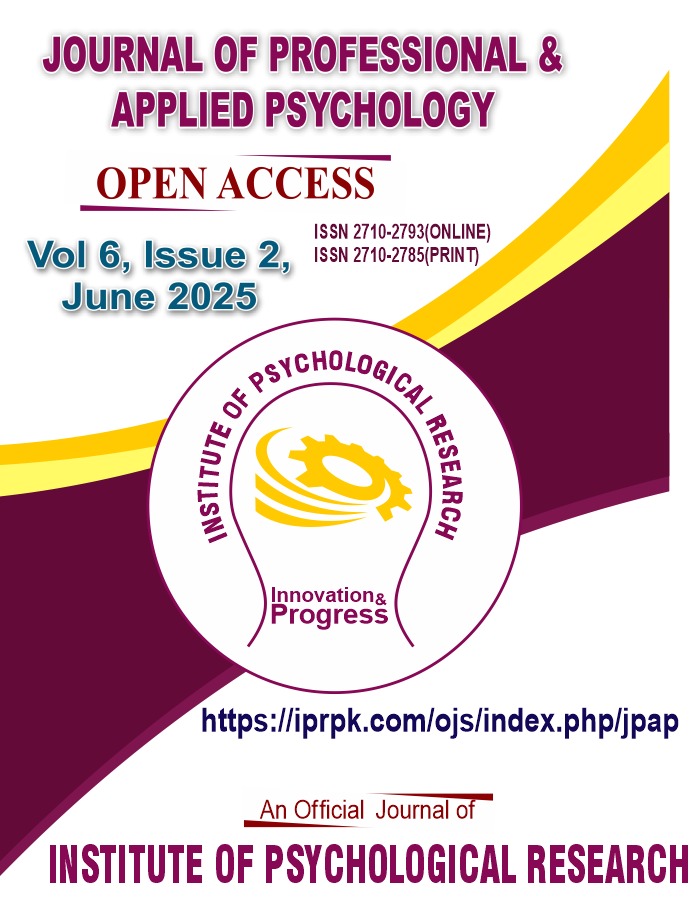Emotional Regulation and Quality of Life among Substance Users
DOI:
https://doi.org/10.52053/jpap.v6i2.377Keywords:
Addiction, Cognitive Reappraisal, Emotional Regulation, Expressive Suppression, Quality of Life, Substance UseAbstract
A substance use disorder is a chronic physical & mental health concern caused by obsessive use of substance, regardless of its adverse effects. A key objective of this study was to examine emotional regulation and its relationship to quality of life among substance users. The study used purposive convenient sampling to collected data from 250 participants with substance dependency aged over 18 years from various rehabilitation facilities spread across five cities. Study measure included drug history Performa with a demographic information sheet using Urdu translated versions of scales Emotional Regulation questionnaire (Gross & John, 2003) which comprises Suppression and Reappraisal subscales and WHOQOL-BREF. According to a descriptive analysis of sample characteristics, the majority of participants were from the middle class and had a family history of substance use. The finding of the correlation of cognitive reappraisal showed a positive relationship with quality of life while expressive suppression showed a negative relationship. However, significant gender differences were found concerning emotional regulation & quality of life. Future study planning can benefit from the findings. Further, therapeutic intervention strategies of emotional regulation for substance users must take these studies into account.
References
Agha, S., Zia, H., &Irfan, S. (2008). Psychological problems and family functioning as risk factors in addiction. Journal of Ayub Medical College Abbottabad, 20(3), 88-91.
Ahmadzee, H. (2015). Global challenges of substance use disorders. International Journal of Psychology and Counselling, 7(3), 35–40.
Aldao, A., Hoeksema, S.N., & Schweizwer, A. (2010). Specificity of cognitive emotion regulation strategies: A transdiagnostic examination. Behavior Research and Therapy, 48(10), 974– 983. https://doi.org/10.1016/j.brat.2010.06.002
Asad, R. (2014). Drug Use in Pakistan 2013 Survey reveals high levels of drug use and dependency. http://www.unodc.org/pakistan/en/drug-use-in-pakistan-2013- survey-reveals-high-levels-of-drug-use-and dependency
Butler, E.A., Egloff, B., Wilhelm, F.H., Smith, N.C., Erickson, E.A., &Gross, J.J. (2003). The social consequences of expressive suppression. Emotion. 3(1), 48-67. https://doi.org/10.1037/1528- 3542.3.1.48
Butt, M., Malik, F., & Hoffmann, H. (2015). Emotion Recognition in Individuals with Substance Use Disorder. Journal of Behavioral Sciences, 25(2), 47-64. https://www.researchgate.net/publication/292604806
Gross, J. J. (2015). Emotion regulation: Current status and future prospects. Psychological Inquiry, 26(1), 1-26. https://doi.org/10.1080/1047840X.2014.940781
Gross, J. J., & John, O. P. (2003). Individual differences in two emotion regulation processes: Implications for affect, relationships, and well-being. Journal of Personality and Social Psychology, 85(2), 348–362. https://doi.org/10.1037/0022-3514.85.2.348
Hjemsæter, A. J., Bramness, J. G., & Drake, R. J. (2019). Substance use disorders in patients with severe mental illness: Prevalence and associations. Frontiers in Psychiatry, 10, 163. https://doi.org/10.3389/fpsyt.2019.00163
Johnston, L.D., O’Malley, P.M., Bachman, J.G., Schulenberg, J.E., & Miech, R.A. (2014). A meta-analytic investigation of the relationship between emotional intelligence and health. Personality and Individual Differences, 42(6), 921-933.
Khan, M. A., Jamil, A., & Khalid, A. (2020). Drug addiction in Pakistan: A socio-psychological analysis. Pakistan Journal of Medical Sciences, 36(2), 228–233. https://doi.org/10.12669/pjms.36.2.1777
Khalid, T., & Kausar, R. (2008). Quality of life and depression in caregivers of stroke patients in Pakistan. Asia Pacific Disability Rehabilitation Journal, 19(2), 103–110.
Manju, H. K., & Basavarejappa (2016), Role of Emotion Regulation in Quality of Life. International Journal of Indian Psychology, 4(1), 81.
Mustafa, A. B. (2019). Impact of Poly-drug and Mono-drug on Aggression and Emotional Dysregulation among Substance Users. Journal of Pakistan Psychiatric Society, 16(4), 9-12. ttps://jpps.pk/index.php/journal/article/view/14
Poon, J. A., Turpyn, C. C., Hansen, A., Jacangelo, J., & Chaplin, T. M. (2015). Adolescent Substance Use & Psychopathology: Interactive Effects of Cortisol Reactivity and Emotion Regulation. Cognitive Therapy and Research, 40(3), 368–380. https://doi.org/10.1007/s10608-015-9729-x
Qasim, M. (2017). Heroin use in Pakistan: A growing crisis. The Express Tribune. https://tribune.com.pk/story/1365375
Shahzadi, M., Fatima, S., & Akram, B. (2023). Emotion regulation strategies and addiction severity among adolescents undergoing rehabilitation. Pakistan Journal of Clinical Psychology, 22(1), 45–58.
Stellern, J., Xiao, K. B., Grennell, E., Sanches, M., Gowin, J. L., & Sloan, M. E. (2023). Emotion regulation in substance use disorders: a systematic review and meta-analysis. Addiction (Abingdon, England), 118(1), 30–47. https://doi.org/10.1111/add.16001
United Nations Office on Drugs and Crime. (2022). World Drug Report 2022. UNODC. https://www.unodc.org/unodc/en/data-and-analysis/world-drug-report-2022.html
Weinberg, A. & Klonsky, E. D. (2009) Measurement of emotion dysregulation in adolescents. Psychological Assessment, 21. 616-621. http://doi.org/10.1037/a0016669
Yen, C.N., Wang, C.S., Wang, T.Y., Chen, H.F., & Chang, H.C. (2010) Quality of life and its correlates among heroin users in Taiwan. Kaohsiung Journal of Medical Sciences, 27(5), 177-83. https://doi.org/10.1016/j.kjms.2010.09.003
Zafar, H., Bashir, S., & Asif, M. (2018). Drug Addiction: A review of challenges and solutions. https://www.researchgate.net/publication/334670685
Downloads
Published
How to Cite
Issue
Section
Categories
License
Copyright (c) 2025 Shaista Almas, Sher Dil, Farah Kanwal

This work is licensed under a Creative Commons Attribution-NonCommercial 4.0 International License.
Creative Commons Attribution-Non Commercial 4.0 International (CC BY-NC 4.0) License: This article is distributed under the terms of the Creative Commons Attribution-Non Commercial 4.0 International License (https://www.creativecommons.org/licenses/by-nc/4.0/) which permits non-Commercial use, reproduction and distribution of the work without further permission provided the original work is attributed as specified on the Journal website at (https://iprpk.com/ojs/index.php/jpap)












